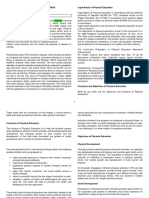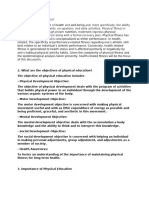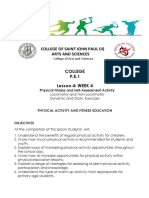MCT Lesson 1
MCT Lesson 1
Uploaded by
bechaydanezrinCopyright:
Available Formats
MCT Lesson 1
MCT Lesson 1
Uploaded by
bechaydanezrinOriginal Title
Copyright
Available Formats
Share this document
Did you find this document useful?
Is this content inappropriate?
Copyright:
Available Formats
MCT Lesson 1
MCT Lesson 1
Uploaded by
bechaydanezrinCopyright:
Available Formats
Republic of the Philippines
CATANDUANES STATE UNIVERSITY
Virac, Catanduanes
Module 1: Course Overview:
Introduction and General Concept
Desired Learning Outcomes
In this module, challenge yourself to attain the following desired learning outcomes:
Demonstrate knowledge and understanding on physical fitness and its components.
Compare and contrast the different health-related and skill-related components.
Evaluate and assess one’s health-related and skill-related fitness component level.
Execute the Physical Fitness Test accurately and properly.
Introduction
Fitness and wellness are essential components of a healthy and fulfilling life. They
encompass physical, mental, and emotional well-being, and are interconnected in creating a
balanced and vibrant lifestyle. By incorporating regular exercise, mindful nutrition, and self- care
practices into our daily routines, we can achieve optimal levels of health and vitality. Prioritizing
our fitness and wellness not only allows us to feel better physically, but also boosts our mood,
energy levels, and overall quality of life.
Individuals who prioritize their wellness and fitness often experience a higher quality of
life, with fewer health issues, improved mood, and increased longevity. Engaging in physical
activity releases endorphins, chemicals in the brain that act as natural painkillers and mood
elevators. This can help reduce stress, anxiety, and depression, and improve overall mental
well-being. Regular exercise and a healthy diet can help individuals maintain a healthy weight,
reduce the risk of chronic diseases such as heart disease, diabetes, and cancer, and improve
overall physical health. Exercising regularly can boost one's energy levels, improve sleep
quality, and enhance overall productivity and performance in daily activities. Regular exercise
can strengthen the immune system and reduce the risk of infections, illnesses, and diseases.
Being healthy is a journey of self-discovery and self-improvement that empowers us to be
the best versions of ourselves. By investing in our fitness and wellness, we are investing in our
future and well-being.
“When we strive to become better than we are, everything around us becomes better too.” –
Paulo Coelho.
Module in PE4 – Sports | 1
Pre-Test
Answer the following with at least three (3) sentences for each number.
1. What is the importance of Fitness?
2. What are the differences between fitness, health, and wellness?
Lesson 1.1 Introduction to Physical Education and Physical Fitness
Physical Education Physical Education is
a comprehensive educational program
which consist of a wide range of activities
intended to facilitate the development of an
individual's physiological aspect to process
develop skills and knowledge through the
use of physical and mind.
With the new understanding of the nature
of human beings in which
wholeness of the individual is the outstanding fact, Physical Education becomes according to
Deborah Wuest and Charles Bucher (1999) defined Physical Education as “an educational
process that uses physical activity as a means to help individuals acquire skills, fitness,
knowledge, and attitudes that contribute to their optimal development and well being”.
Physical fitness, in general terms, is a person’s ability to meet the physical stresses and
demands of a variety of physical activities efficiently and effectively. Physical fitness provides a
person with the capacity to perform work safely in activities of daily living, including activities
required for work at home and in the workplace, for leisure-time pursuits, and for sports. The
physical stresses and demands of daily living range, for example, from sitting, eating, standing,
showering, and walking to the extreme physical demands of shoveling after a major snowstorm,
marathon running, participating in a triathlon, and firefighting. Each of these activities requires
Module in PATHFit 1 – Movement Competency Training
varying degrees of cardiorespiratory endurance (CRE), muscular strength, muscular endurance,
and flexibility to perform it well. Fortunately, the physical demands of showering or walking are not
great, making it quite easy for most of us to engage in these physical activities. For a small
percentage of the population these activities pose difficulty. Many people are faced with
demanding tasks, such as lifting/carrying heavy objects, building, and snow shovelling, which can
over-stress the body if it does not have an adequate level of physical fitness. Adequate
preparation for these periodic tasks is essential to help minimize the risks of heart attack, stroke,
and back injury. On the other end of the physical activity continuum are the occupations and
activities that fall outside the realm of possibility for most of us. These activities require physical
fitness levels and skills that are beyond our contemplation or aspiration. They are performed by
people who have been genetically gifted and have worked and trained for years to perform at the
extreme levels required for these physical activities.
Instructions:
1. Choose a topic or theme about fitness that you would like to create a word
cloud about.
2. Use a word cloud generator tool such as WordArt or TagCrowd to create
your own word cloud. You can also create a word cloud manually by writing
the words on paper and arranging them in a visually appealing way.
3. Select the words you want to include in your word cloud. These can be key
words or phrases related to your chosen topic.
4. Experiment with different fonts, colors, and layouts to make your word cloud
visually interesting and engaging.
5. Once you are happy with your word cloud, consider sharing it with others or
displaying it in a creative way, such as printing it out and framing it, or
incorporating it into a presentation or project.
Sample of a Word Cloud
Module in PATHFit 1 – Movement Competency Training
Lesson 1.2 Wellness and Fitness
What are the differences
between fitness and The major goal of PE is
FITNESS
AND
wellness?
WELLNESS
Fitness refers to physical health and the ability to perform
daily activities without getting tired easily. It is usually
measured by factors such as strength, endurance, flexibility,
and cardiovascular health. Wellness, on the other hand,
encompasses physical, mental, and emotional well-being. It
focuses on overall health and happiness in all aspects of life.
SLOGAN MAKING:
1. Make a Slogan about your fitness goal this semester.
2. Use a White bond paper, and coloring materials.
3. Submit it to your instructor for proper evaluation.
4. Originality must be observe. DO NOT PLAGIARIZE.
5. Be guided on the rubrics below.
5 pts 4 pts 3 pts 2pts
Module in PATHFit 1 – Movement Competency Training
Lesson 1.3 Objectives of Physical Education
LEGAL BASIS OF PHYSICAL EDUCATION
REPUBLIC ACT NO. 5708, June 21, 1969 ("The Schools Physical Education and
Sports Development Act)
An act providing for the promotion and financing of an integrated physical education and
sports development program for the schools in the Philippines
Article 1, International Charter of Physical Education and Sports, UNESCO, Paris,
1978 and Recommendation 1
1.1. Every human being has a fundamental right of access to physical education and sport,
which are essential for the full development of his personality. The freedom to develop
physical, intellectual and moral powers through physical education and sport must be
guaranteed both within the educational system and in other aspects of social life.
1.2. Everyone must have full opportunities, in accordance with his national tradition of sport,
for practicing physical education and sport, developing his physical fitness and attaining a
level of achievement in sport which corresponds to his gifts.
1.3. Special, opportunities must be made available for young people, including children of
pre‐school age, for the aged and for the handicapped to develop their personalities to the
full through physical education and sport programmes suited to their requirements.
Presidential Decree NO. 604 (December 10, 1974)
Acknowledges the vital role of physical fitness and amateur sports in developing citizens,
and recognizes the need to integrate youth development into national policy. It establishes
the Department of Youth and Sports Development to coordinate physical fitness programs
and amateur sports activities across all ages and levels of society. Executive Order No. 63
from 1993 also promotes physical education and sports to develop self-discipline and
excellence in citizens and facilitates the establishment of sports councils at all government
levels to support programs.
Article XIV, Section 19, 1987 Philippine Constitution
The State shall promote physical education and encourage sports programs, league
competitions, and amateur sports, including training for international competitions, to foster
self-discipline, teamwork, and excellence for the development of a healthy and alert
citizenry.
All educational institutions shall undertake regular sports
activities throughout the country in cooperation with
athletic clubs and other sectors.
Module in PATHFit 1 – Movement Competency Training
Physical Development
Through cautiously selected activities, an
individual who participates energetically will
develop and maintain good health and physical
fitness. The attainment of physical skills can
motivate an individual who participates further in
physical activities; hence growth and development
will be improved.
Social Development
Provides opportunities for the development of
enviable social traits through socials in physical
activities. Through active participation, students
develop positive desirable traits like cooperation,
sportsmanship, camaraderie, leadership,
respect, and honesty.
Mental Development
Students develop their mental capacities as they
learn the principles of underlying movements.
Moreover, students acquire knowledge and
understanding of the rules and strategies of the
games, sports, dance, and many more, and
likewise enhance critical thinking skills
Emotional Development
Provide opportunities for self-expression and
emotional mastery. People who have more
positive feelings towards physical activities are
said to have a more positive balance of feelings
which increases and develops self-confidence,
self-reliance, and self-control.
Module in PATHFit 1 – Movement Competency Training
Lesson 1.4 Health Related and Skill Related Components
The components of Physical Fitness are
divided into two categories the health-related
components (Flexibility, Cardiorespiratory
Endurance, Muscular Strength, Muscular
Endurance and Body Composition) and the
performance-related components (Agility,
Balance, Coordination, Power, and Speed).
Health-Related Fitness is a function of body's adaptation to exercise. It could be
developed and maintain through the regular and proper exercise program. It also
focuses on the general aspects of physical fitness that are important for overall health
and well-being
Cardiovascular Endurance
This refers to the ability of the heart, blood vessels and the lungs to
adapt to physical exertion for a prolonged duration. Usually, the heart
rate is increased from the resting pulse rate to target heart rate that
the individual has to sustain for a period of 20 to 60 minutes. With high
levels of endurance, an individual has more energy and has the ability
to sustain different types of It is also likely that coronary heart disease
(CHD) is prevented.
Muscular Strength
It is the amount of force you can put forth with your muscles. It is often
measured by how much weight you can lift. People with strength have
fewer problems with backaches and can carry out their daily tasks
efficiently. Muscular Strength may be developed through isotonic,
isometric, or isokinetic contractions.
Isotonic Contractions are voluntary contractions in which
muscles changes lengths. These contractions are of two types:
Module in PATHFit 1 – Movement Competency Training
1. Concentric Contraction - refers to muscles that shorten under tension.
Muscles rises to meet the resistance and becomes stable as muscle
shortens.
2. Eccentric Contraction refers to the muscle that lengthens under
tension. Muscles exert force due to an outside resistance. Muscle
lengthens as resistance becomes greater.
Isometric Contractions are
another type of contractions in
which the muscles are
contracted against an
immovable resistance. Muscle
contracts without lengthening
or shortening, another term for
static contraction. The
exercise provides maximum
contraction of muscle;
however, there is no observed
movement during the exercise.
This is done for about 5
seconds.
Isokinetic Contractions are similar to isotonic contractions but the
muscles are exposed to fixed machines with variable degrees of
resistance. Muscles changes length during contractions and
produce movement of a constant speed. Through the range of
movement, resistance is equal to the force applied. Example is
cycling on a stationary bike
Muscular Endurance
This refers to the ability of the muscle to endure a sub maximal effort for a prolonged
period of time. Performing a strength exercise such as push-up over a long period of time
or performing the same exercise for many continuous repetitions is a demonstration of
muscular endurance. One basic requirement in achieving muscular endurance is
muscular strength. Muscle endurance is developed by employing the different strength
training exercises mentioned above either for longer periods of time or an increased
number of exercise repetitions.
Flexibility
Flexibility is the ability of the muscles and joints to go through a full range motion.
Flexibility reduces the risk of injury, enhances performance and prevents muscle
soreness. It is achieved through stretching designed to lengthen or elongate soft tissue
structures and thereby increase the range of motion. Flexibility is influenced by three
factors: 1. Structure of the joints; 2. Amount of tissues surrounding the joint; and 3.
Extensibility of the ligaments, tendons and muscle tissue that connects the joints.
Module in PATHFit 1 – Movement Competency Training
Body Composition
Body Composition refers to the proportion of lean body mass to fat body mass. It stresses
one's relative fatness or leanness in relation to height. In recent years, body composition
has gained wide acceptance in exercise science as one of the components of health-related
fitness. Its inclusion was earlier opposed since supporters believe that fitness is for
everyone, including the slim and overweight. In addition, being fat has some genetic
predisposition that may be quite difficult to alter.
Somatotypes - Somatotyping or body typing is a system of classifying an individual
according to the shape of the body. It was developed by Sheldon during the 1940's and
1950's. He noted that the physique of the body may be categorized into three distinct types:
Ectomorph body type is characterized as a lean and small body build with a greater surface
area to mass ratio. Bone size is relatively small with slender limbs and low muscle mass.
Mesomorph body type has a relative predominance of muscles. The bones are usually
large and heavy with massive limbs, thus contributing to greater weight than the
ectomorphic body type.
Endomorphic body type is characterized by a relative predominance of soft roundness and
large digestive viscera. There is a greater percentage of body fat when compared to lean
body mass
Skill related fitness, refers to the ability to perform specific skills or tasks related to a
particular sport or activity, such as agility, speed, coordination, balance, power, and
reaction time.
Module in PATHFit 1 – Movement Competency Training
Agility
Agility is the ability to move quickly and to easily change direction.
Basketball players, for instance, are incredibly agile. During the game,
you can observe them, jumping, sliding, twisting and backpedaling in
quick response to the movement of the ball and other players
Balance
Balance is the state of equilibrium. Balance refers to the ability of the
body position to remain upright. It deals with proprioception, or
knowing where your body is in space, and being able to adjust your
position as your center of gravity changes during movement (Aman
et al., 2015)
Static balance Dynamic balance
Static Balance is the ability to Dynamic Balance is the ability to
maintain equilibrium in a fixed maintain one's equilibrium while the
position such as standing on one body is in motion. Walking on a
foot or on a balance beam balance beam is one example of
this type of balance.
Speed
It is the ability to perform a task or move from one point to another in
the shortest possible time. It is also the time spent finishing or
completing a performance after the initial movement has been
made. Speed is influenced by the reaction time which is the time
elapsed when the "go" signal has been made by an official of the
first motor response.
Coordination
Reaction time
Coordination is the
Power
Reaction time refers to harmonious working
Power combines speed how quickly you can relationship between the
and strength. Wood respond to an external skeletal muscle and
(2010) author of Topend stimulus. Reaction time nerves in one aspect of
Sports Website, defined hinges heavily on your movement. Hand-eye
power as the ability to mind-body connection. coordination is
exert a maximal force in as Your eyes see a stimulus, demonstrated in certain
short a time as possible, your mind interprets the sport skills such as
as in accelerating. stimulus, and your body catching, passing,
jumping, and throwing reacts in accordance with dribbling or volleying a
implements. that interpretation ball.
Module in PATHFit 1 – Movement Competency Training
Module in PATHFit 1 – Movement Competency Training
You might also like
- PATHFit 1Document18 pagesPATHFit 1Roan Redyna MariñasNo ratings yet
- Fitness Exercise PresentationDocument39 pagesFitness Exercise Presentationreymark estopa100% (2)
- Signed Off - Physical Education11 - q2 - m4 - Health Related Fitness Components and Fitness Target - v3Document23 pagesSigned Off - Physical Education11 - q2 - m4 - Health Related Fitness Components and Fitness Target - v3Gemmy Ronald Teves71% (7)
- Pathfit 1 Module JDocument14 pagesPathfit 1 Module JskyridleyriparipNo ratings yet
- Pathfit NotesDocument3 pagesPathfit NotesAlvarez, Chesna LoiseNo ratings yet
- Cas - Human Kinetics DepartmentDocument57 pagesCas - Human Kinetics DepartmentKent Vincent B. PerezNo ratings yet
- Phed Reviewer Prelims Midterms FinalsDocument43 pagesPhed Reviewer Prelims Midterms FinalsDaniella GarelloNo ratings yet
- Final Module in PEH 1Document60 pagesFinal Module in PEH 1Mary Ann PaladNo ratings yet
- Physical Fitness - Definition and It's Components - 0Document6 pagesPhysical Fitness - Definition and It's Components - 0rashedaunnong0No ratings yet
- Physical EducationDocument4 pagesPhysical EducationEmmanuel DianaNo ratings yet
- Pathfit 1 Module 1Document7 pagesPathfit 1 Module 1aizelpoguilla09No ratings yet
- PATHFIT 2 Module 1Document18 pagesPATHFIT 2 Module 1BLOCK 6 - SIAGONo ratings yet
- Study Guide PathfitDocument5 pagesStudy Guide PathfitDaisy CardanoNo ratings yet
- Fitt 1 (Movement Enhancement) Handout Page - 1Document10 pagesFitt 1 (Movement Enhancement) Handout Page - 1Dollie May Maestre-TejidorNo ratings yet
- Shs 11 Pe Health M 1 2Document11 pagesShs 11 Pe Health M 1 2Chloe AlceraNo ratings yet
- Phed Week Pre-Lim ModuleDocument21 pagesPhed Week Pre-Lim ModuleFerndale AlimondoNo ratings yet
- Physical EducationDocument2 pagesPhysical EducationGerard Philip AgdumaNo ratings yet
- P.E 1 Module1Document5 pagesP.E 1 Module1Cherry lyn EnadNo ratings yet
- Avite Tate Niversity Main Campus College of Sports, Physical Education and Recreation (Cspear)Document11 pagesAvite Tate Niversity Main Campus College of Sports, Physical Education and Recreation (Cspear)Juan Marcos100% (1)
- PHYSICAL-EDUCATIONand HealthDocument35 pagesPHYSICAL-EDUCATIONand HealthEMNASE, Rea Mae, M.No ratings yet
- BPEd 101 102Document52 pagesBPEd 101 102julegojaNo ratings yet
- Reviewer PathfitDocument10 pagesReviewer PathfitCherish Faith TubigNo ratings yet
- What Is Physical Education - NotesDocument16 pagesWhat Is Physical Education - Notess2300086No ratings yet
- PE1 Module 2Document4 pagesPE1 Module 2John Mark GalangNo ratings yet
- PATHFIT 1 Module 1 FinalDocument19 pagesPATHFIT 1 Module 1 Finalfeldarlene llacunaNo ratings yet
- Module 1 Pe 101 Lecture Notes 77 - CompressDocument15 pagesModule 1 Pe 101 Lecture Notes 77 - CompressRhica DioncoNo ratings yet
- PE ReviewerDocument10 pagesPE ReviewerVon AmirNo ratings yet
- Earning Outcomes: LSPU Self-Paced Learning Module (SLM)Document17 pagesEarning Outcomes: LSPU Self-Paced Learning Module (SLM)Aldrin Hardy PabloNo ratings yet
- Lesson 1-Concepts of Physical EducationDocument6 pagesLesson 1-Concepts of Physical EducationJohnnia Marian GerveroNo ratings yet
- College of Saint John Paul (Ii) Arts and Sciences: Physical Fitness and Self-Assessment ActivityDocument12 pagesCollege of Saint John Paul (Ii) Arts and Sciences: Physical Fitness and Self-Assessment ActivityKoolecarla BernardoNo ratings yet
- Pe-101 Lesson 4 DBM Module-In-Physical-EducationDocument20 pagesPe-101 Lesson 4 DBM Module-In-Physical-EducationaprilroseabunyawanNo ratings yet
- Lesson 1 IntroductionDocument18 pagesLesson 1 IntroductionmichaellaNo ratings yet
- Physical Education Came From The Latin Word "Physica", Meaning Physiques and "Educatio"Document14 pagesPhysical Education Came From The Latin Word "Physica", Meaning Physiques and "Educatio"Nica De Juan100% (1)
- Unit 1 Module Physical FitnessDocument22 pagesUnit 1 Module Physical FitnessKhione100% (1)
- Module 3 Health Related Fitness ComponentsDocument25 pagesModule 3 Health Related Fitness Componentsjeffrey ordinalNo ratings yet
- CORE PE and Health Module 1Document3 pagesCORE PE and Health Module 1Princess CunananNo ratings yet
- Physical EducationDocument25 pagesPhysical EducationraksnghNo ratings yet
- Physical Education Unit Physical Activity Towards Health and Fitness 1Document11 pagesPhysical Education Unit Physical Activity Towards Health and Fitness 1John Joel RafaelNo ratings yet
- Physical EducationDocument10 pagesPhysical EducationMooyong ChoiNo ratings yet
- Objective of Physical Educaton: Good LifeDocument8 pagesObjective of Physical Educaton: Good LifeLorraine AlboNo ratings yet
- G11 PEH1 Module 3Document18 pagesG11 PEH1 Module 3erra100% (1)
- Module 1Document5 pagesModule 1Ray BurlatNo ratings yet
- Pe1 Las Week2Document3 pagesPe1 Las Week2crisanto.gudia01No ratings yet
- PEDocument10 pagesPERaul OrcigaNo ratings yet
- Physical EducationDocument4 pagesPhysical EducationMelisa Mabacquiao SerquillosNo ratings yet
- PATHFIT 1-FINAL Module!! FS 2022 - CompressedDocument36 pagesPATHFIT 1-FINAL Module!! FS 2022 - CompressedZherwin Latu-ab100% (6)
- Week 1Document6 pagesWeek 1Jhona Marie FuellasNo ratings yet
- Pe 111 Prelim 2021Document40 pagesPe 111 Prelim 2021April Jane TabilleranNo ratings yet
- Physical Literacy Is The Development of A Range of Basic Human MovementsDocument15 pagesPhysical Literacy Is The Development of A Range of Basic Human MovementsFRANCIS FRANCISCO. CLIMACONo ratings yet
- Lesson 2Document23 pagesLesson 2Arriene Chris Ocho DiongsonNo ratings yet
- Path FitDocument27 pagesPath FitkrisevvoneNo ratings yet
- Practical ExamDocument8 pagesPractical ExamRexNo ratings yet
- Physical Education and Its DevelopmentDocument7 pagesPhysical Education and Its DevelopmentJazal OmarNo ratings yet
- M1 - Week 1Document5 pagesM1 - Week 1Jenard H. AdorioNo ratings yet
- Learning Plan Week 3 First Quarter 2022 2023Document8 pagesLearning Plan Week 3 First Quarter 2022 2023Almerto RicoNo ratings yet
- Foundation of Physical Education UNIT 2Document6 pagesFoundation of Physical Education UNIT 2Sreelakshmi MuttomNo ratings yet
- Week 1 Module PATHFIT1Document5 pagesWeek 1 Module PATHFIT1Lalay RanqueNo ratings yet
- PE01 MODULE 1 Introduction To PEDocument17 pagesPE01 MODULE 1 Introduction To PEAlbert Fabros GapasinNo ratings yet
- Pathfit QuestionsDocument3 pagesPathfit QuestionsFrannie BorrasNo ratings yet



























































